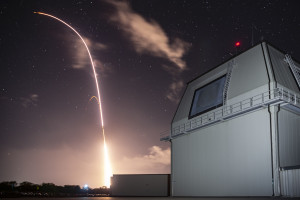
The Missile Defense Agency (MDA) and Navy successfully intercepted an Intermediate Range Ballistic Missile (IRBM) target with an Aegis Ashore-launched Raytheon [RTN] Standard Missile-3 (SM-3) Block IIA interceptor in the Pacific Ocean this week using an Aegis configuration being developed for Japan.This operational live fire flight test, called Flight Test Integrated-03 (FTI-03), used an air-launched IRBM target fired from an Air Force C-17 from an ocean area thousands of miles southwest of Hawaii. The Aegis Ashore Missile Defense Test Complex at the…

 By
By 











